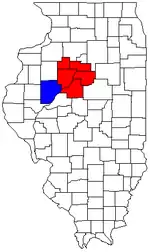Peoria, Illinois, metropolitan area
The Peoria Metropolitan Statistical Area, as defined by the United States Census Bureau, is an area consisting of six counties in Central Illinois, anchored by the city of Peoria. As of the 2020 census, the area had a population of 402,391.[1] The City of Peoria, according to the 2020 US Census Bureau, has 113,150 people.[2]

Communities
| Census | Pop. | Note | %± |
|---|---|---|---|
| 1900 | 121,629 | — | |
| 1910 | 134,282 | 10.4% | |
| 1920 | 150,250 | 11.9% | |
| 1930 | 187,426 | 24.7% | |
| 1940 | 211,736 | 13.0% | |
| 1950 | 250,512 | 18.3% | |
| 1960 | 334,898 | 33.7% | |
| 1970 | 362,791 | 8.3% | |
| 1980 | 387,732 | 6.9% | |
| 1990 | 358,552 | −7.5% | |
| 2000 | 366,899 | 2.3% | |
| 2010 | 379,186 | 3.3% | |
| 2020 | 402,391 | 6.1% | |
| U.S. Decennial Census[3] | |||
Places with more than 100,000 inhabitants
- Peoria (principal city)
Places with 10,000 to 40,000 inhabitants
Places with 2,500 to 10,000 inhabitants
Places with 1,000 to 2,500 inhabitants
Places with fewer than 1,000 inhabitants
Unincorporated places
- Alta
- Broadmoor
- Camp Grove
- Castleton
- Cramers
- Edelstein
- Edgewater
- Edwards
- El Vista
- Elmore
- Galena Knolls
- Groveland
- High Meadows
- Holmes Center
- Hopewell Estates
- Komatsu Dresser
- Lake Camelot
- Lake Lancelot
- Lake of the Woods
- Laura
- Lawn Ridge
- Leeds
- Lombardville
- Lowpoint
- Mardell Manor
- Modena
- Monica
- Mossville
- North Hampton
- Oak Hill
- Oak Ridge
- Orchard Mines
- Pattonsburg
- Pottstown
- Renchville
- Rome Heights
- Saratoga Center
- Saxton
- Smithville
- South Rome
- Southport
- Speer
- Spires
- Tuscarora
- Vets Row
- Vonachen Knolls
- West Hallock
- Wilbern
- Woodford
Townships
- Akron
- Bell Plain
- Bennington
- Boynton
- Brimfield
- Cazenovia
- Chillicothe
- Cincinnati
- Clayton
- Cruger
- Deer Creek
- Delavan
- Dillon
- El Paso
- Elm Grove
- Elmira
- Elmwood
- Essex
- Evans
- Fondulac
- Goshen
- Greene
- Groveland
- Hallock
- Henry
- Hittle
- Hollis
- Hopedale
- Hopewell
- Jubilee
- Kansas
- Kickapoo
- La Prairie
- Lacon
- Limestone
- Linn
- Little Mackinaw
- Logan
- Mackinaw
- Malone
- Medina
- Metamora
- Millbrook
- Minonk
- Montgomery
- Morton
- Olio
- Osceola
- Palestine
- Panola
- Partridge
- Pekin
- Penn
- Princeville
- Radnor
- Richland
- Richwoods
- Roanoke
- Roberts
- Rosefield
- Sand Prairie
- Saratoga
- Spring Bay
- Spring Lake
- Steuben
- Timber
- Toulon
- Tremont
- Trivoli
- Valley
- Washington
- West Jersey
- West Peoria
- Whitefield
- Worth
Combined Statistical Area

The Peoria–Canton Combined Statistical Area was made up of six counties in central Illinois. The statistical area includes one metropolitan area and one micropolitan area. As of the 2000 Census, the CSA had a population of 405,149 (though a July 1, 2009 estimate placed the population at 412,517).[4] US Census Bureau integrated the previous Canton Statistical Area into the Peoria MSA, therefore now the CSA is now longer in existence.
- Metropolitan Statistical Areas (MSAs)
- Peoria (Marshall, Peoria, Stark, Tazewell Fulton and Woodford counties)
Demographics
As of the census[5] of 2020, there were 402,391 people within the MSA. The racial makeup of the MSA was 88.54% White, 8.40% African American, 0.23% Native American, 1.05% Asian, 0.02% Pacific Islander, 0.59% from other races, and 1.18% from two or more races. Hispanic or Latino of any race were 1.52% of the population.
The median income for a household in the MSA was $42,805, and the median income for a family was $50,756. Males had a median income of $38,135 versus $23,793 for females. The per capita income for the MSA was $20,104.
See also
References
- "Peoria (Metropolitan Statistical Area, Metropolitan Areas, USA) - Population Statistics, Charts, Map and Location". www.citypopulation.de. Retrieved 2021-12-11.
- "Peoria (city) QuickFacts from the US Census Bureau".
- "U.S. Decennial Census". United States Census Bureau. Archived from the original on May 7, 2015. Retrieved April 12, 2020.
- "Table 2. Annual Estimates of the Population of Combined Statistical Areas: April 1, 2000 to July 1, 2009 (CBSA-EST2009-02)". 2009 Population Estimates. United States Census Bureau, Population Division. 2010-03-23. Archived from the original (CSV) on April 20, 2010. Retrieved 2010-03-26.
- "U.S. Census website".
